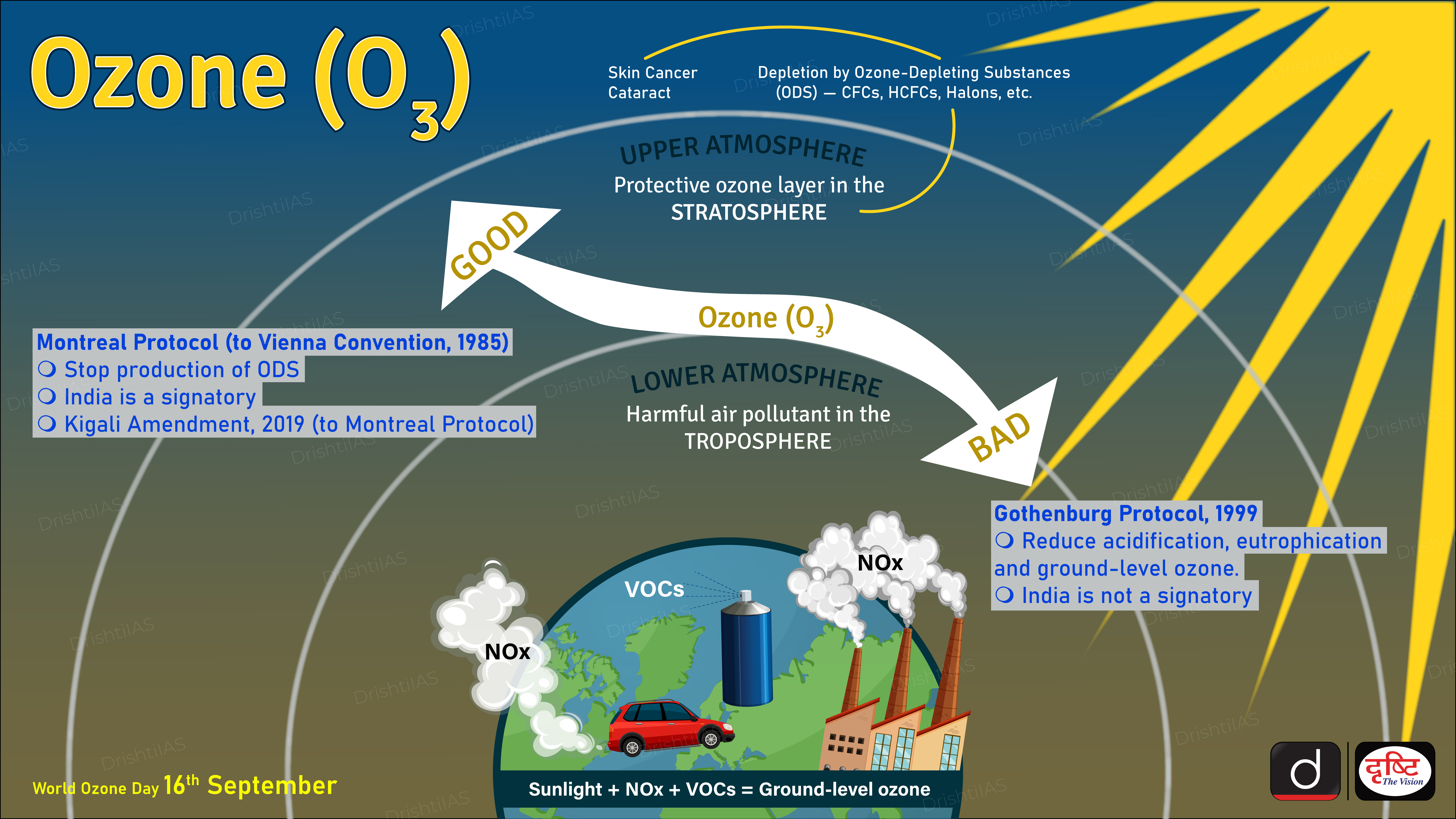Important Facts For Prelims
Recovery of Ozone Layer
- 11 Jan 2023
- 8 min read
Why in News?
According to a new U.N. report, earth’s protective ozone layer is slowly but noticeably healing at a pace that would fully mend the hole over Antarctica in about 43 years.
What are the Findings of the Report?
- While this is an achievement, the scientists warned of the detrimental effects of geoengineering technologies such as stratospheric aerosol injection on the ozone layer.
- Aerosol sprays, like other commonly used substances such as dry-cleaning solvents, refrigerants and fumigants, contain Ozone-Depleting Substances (ODS) including chlorofluorocarbons (CFCs), hydrochlorofluorocarbons (HCFCs), halons, methyl bromide, carbon tetrachloride, and methyl chloroform.
- For the first time, the Scientific Assessment Panel examined the potential effects on ozone of the intentional addition of aerosols into the stratosphere, known as Stratospheric Aerosol Injection (SAI).
- SAI can increase sunlight reflection, thereby lowering the amount of heat that enters the troposphere. But this method “could also affect stratospheric temperatures, circulation and ozone production and destruction rates and transport".
What are the Key Facts about Ozone?
- Ozone is a special form of oxygen with the chemical formula O3. The oxygen we breathe and that is so vital to life on earth is O2.
- About 90% of ozone occurs naturally in the Earth's upper atmosphere (Stratosphere) between 10 and 40 km above Earth's surface, where it forms a protective layer that shields us from the sun's harmful ultraviolet rays.
- This “good” ozone is gradually being destroyed by man-made chemicals referred to as ODS, including CFCs, HCFCs, halons, methyl bromide, carbon tetrachloride, and methyl chloroform.
- When chlorine and bromine atoms come into contact with ozone in the stratosphere, they destroy ozone molecules.
- One chlorine atom can destroy over 100,000 ozone molecules before it is removed from the stratosphere.
- Ozone can be destroyed more quickly than it is naturally created.
- Ozone layer depletion leads to an uptick in the incidence of skin cancer and cataracts in humans.
What are the Related Steps taken?
- Vienna Convention:
- The 1985 Vienna Convention for the Protection of the Ozone Layer provided a framework for international cooperation on ozone protection.
- Montreal Protocol (under Vienna Convention):
- Adopted in 1987, the Montreal Protocol is a worldwide agreement to stop the production of substances causing ozone-depletion.
- Kigali Amendment to the Protocol: Parties to the Montreal Protocol agreed to phase down production and consumption of Hydrofluorocarbons, commonly known as HFCs.
UPSC Civil Services Examination, Previous Year Question (PYQ)
Q1. Which one of the following is associated with the issue of control and phasing out of the use of ozone depleting substances? (2015)
(a) Bretton Woods Conference
(b) Montreal Protocol
(c) Kyoto Protocol
(d) Nagoya Protocol
Ans: (b)
Exp:
- The Bretton Woods Conference, officially known as the United Nations Monetary and Financial Conference was a gathering of delegates from 44 nations that met in 1944 in Bretton Woods (USA) to agree upon a series of new rules for the post-World War-II international monetary system.
- The two major accomplishments of the conference were the creation of the International Monetary Fund (IMF) and the International Bank for Reconstruction and Development (IBRD).
- The Montreal Protocol is an international environmental agreement to protect the earth’s ozone layer by eliminating the use of ozone depleting substances. Adopted on 15th September 1987, the protocol is to date the only UN treaty that ever has been ratified by every country on Earth – all 197 UN member states.
- The Kyoto Protocol is an international agreement linked to the UNFCCC, which commits its Parties by setting internationally binding GHGs (Greenhouse Gases) emission reduction targets.
- The Kyoto Protocol was adopted in Kyoto, Japan on 11th December 1997 and entered into force on 16th February 2005.
- The detailed rules for the implementation of the protocol were adopted as CoP7 in Marrakesh, Morocco in 2001 and referred as the Marrakesh Accord.
- India has ratified the second commitment period (2008‑2012) of the Kyoto protocol, that commits countries to contain emissions of greenhouse gases, reaffirming its stand on climate action.
- The Nagoya Protocol on Access to Genetic Resources and the Fair and Equitable Sharing of Benefits Arising from their Utilization provides a transparent legal framework for the effective implementation of one of the three objectives of the Convention on Biological Diversity: the fair and equitable sharing of benefits arising out of the utilization of genetic resources, to promote sustainable use of biological diversity. India signed the protocol in 2011.
- Therefore, option B is the correct answer.
Q2. Consider the following statements: (2012)
Chlorofluorocarbons, known as ozone-depleting substances, are used
- in the production of plastic foams
- in the production of tubeless tyres
- in cleaning certain electronic components
- as pressurizing agents in aerosol cans
Which of the statements given above is/are correct?
(a) 1, 2 and 3 only
(b) 4 only
(c) 1, 3 and 4 only
(d) 1, 2, 3 and 4
Ans: (c)
- Chlorofluorocarbons (CFCs) are nontoxic, nonflammable chemicals containing atoms of Carbon, Chlorine and Fluorine. They are widely used as refrigerants, propellants (in aerosol applications), and solvents.
- The Montreal Protocol is an international agreement made in 1987 to stop the production and import of ozone depleting substances such as chlorofluorocarbons and reduce their concentration in the atmosphere to help protect the earth’s ozone layer.
- India completely phased out production and consumption of CFCs, carbon tetrachloride and halons.
- Use of CFCs
- Refrigeration
- Making of plastic foams; hence, statement 1 is correct.
- As pressurising agent in aerosol cans; hence, statement 4 is correct.
- As cleaning agent for electronic products. hence, statement 3 is correct.
- However tubeless tyre industry does not use CFCs. Hence, statement 2 is not correct. Therefore, option (c) is the correct answer.







